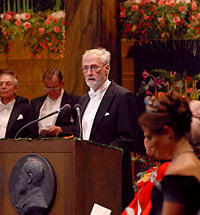Award ceremony speech
Presentation Speech by Professor Håkan Wennerström, Member of the Royal Swedish Academy of Sciences; Member of the Nobel Committee for Chemistry, 10 December 2007
 |
| Professor Håkan Wennerström delivering the Presentation Speech for the 2007 Nobel Prize in Chemistry at the Stockholm Concert Hall. Copyright © The Nobel Foundation 2007 Photo: Hans Mehlin |
Your Majesties, Your Royal Highnesses, Ladies and Gentlemen,
The central theme of chemistry is the chemical reaction. It is about how molecules are synthesized, transformed and degraded. This year’s Nobel Laureate in chemistry, Gerhard Ertl, is receiving the award because he has revealed how chemical reactions occur when the molecules of a gas hits a solid surface. The atoms of the molecules can be aided by the surface to generate new combinations. We chemists call this surface catalysis. The reaction of the molecules of the gas with the surface can also lead to its gradual degradation, and chemists call this corrosion.
With his research, Professor Ertl has provided intellectual and concrete tools to meet a number of challenges we are currently facing. We all know that efficient energy usage is a matter of high urgency. One way to improve resource utilisation is to change from combustion engines to engines based on fuel cell technology. Here the central problem is to control surface reactions. We hear about production failures at nuclear power plants caused by corrosion damage. These power plants produce radioactive waste for which we seek secure storage. The corrosion that can take place over millennia then becomes a matter of concern.
In daily life we are used to seeing the superficial appearance of the events around us. It is more difficult to penetrate beneath the surface. In chemistry it is the reverse. Only a minute fraction of the molecules reside on the surface. When studying processes that occur on surfaces it is necessary to utilise physical effects that are selectively sensitive to the molecules there. These are few, and therefore the signals are weak and the information is scattered. In his research, Professor Ertl has shown that it is necessary to combine the fragmented information from a number of techniques to obtain a complete picture.
Professor Ertl demonstrated the strength of his methodology by systematically revealing all the steps in the reaction in which the nitrogen of the air is combined with hydrogen to form ammonia, using surface catalysis. This technical process, designed by Haber and Bosch, has been the source of fertilizers for a whole world for a hundred years. The question of the mechanism of the reaction had been a scientific enigma for decades when Professor Ertl finally succeeded in describing the entire chain of molecular events in detail.
He again proved the versatility of his research methods in another series of studies in which he clarified the subtle feedback mechanisms in the reaction occurring on the catalytic converters in the exhaust systems of our cars. In this system, where poisonous carbon monoxide is converted to carbon dioxide, there is interplay between the structure of the solid and the reacting gases. This interplay leads to the formation of molecular patterns on the surfaces that are constantly in motion impelled by the chemical reaction. Pictures from the experiments are instructive but also so beautiful that they give associations to Dadaistic art.
Professor Ertl has shown the research community how one arrives at a deeper understanding of molecular processes on surfaces. His work provides an illustration of a fruitful interplay between basic research and its practical application. Using his knowledge about technical problems he identified an area for fundamental studies. He provided a number of answers to general questions through studies of systems that had only a remote connection to the technical reality. Then he and others could demonstrate that the fundamental phenomena also manifest themselves in complex technical processes.
Sehr geehrter Professor Ertl: für Ihre Untersuchungen über chemische Reaktionen an festen Oberflächen wurden Sie mit dem Nobelpreis für Chemie des Jahres 2007 ausgezeichnet. Durch Ihre zielbewußte und geduldige Arbeit haben Sie mit großer intellektueller Klarheit gezeigt, wie man molekulare Vorgänge auf Oberflächen untersucht. Die Essenz Ihrer Arbeit, das Verständnis über eben jene Oberflächenvorgänge, bildet eine Grundlage für die Lösung von technischen und wissenschaftlichen Herausforderungen unserer Zeit.
Im Namen der Königlichen Schwedischen Akademie der Wissenschaften möchte ich Ihnen herzlich zu dieser Auszeichnung gratulieren und bitte Sie, den Nobelpreis aus den Händen seiner Majestät des Königs entgegenzunehmen.
Nobel Prizes and laureates
Six prizes were awarded for achievements that have conferred the greatest benefit to humankind. The 12 laureates' work and discoveries range from proteins' structures and machine learning to fighting for a world free of nuclear weapons.
See them all presented here.
